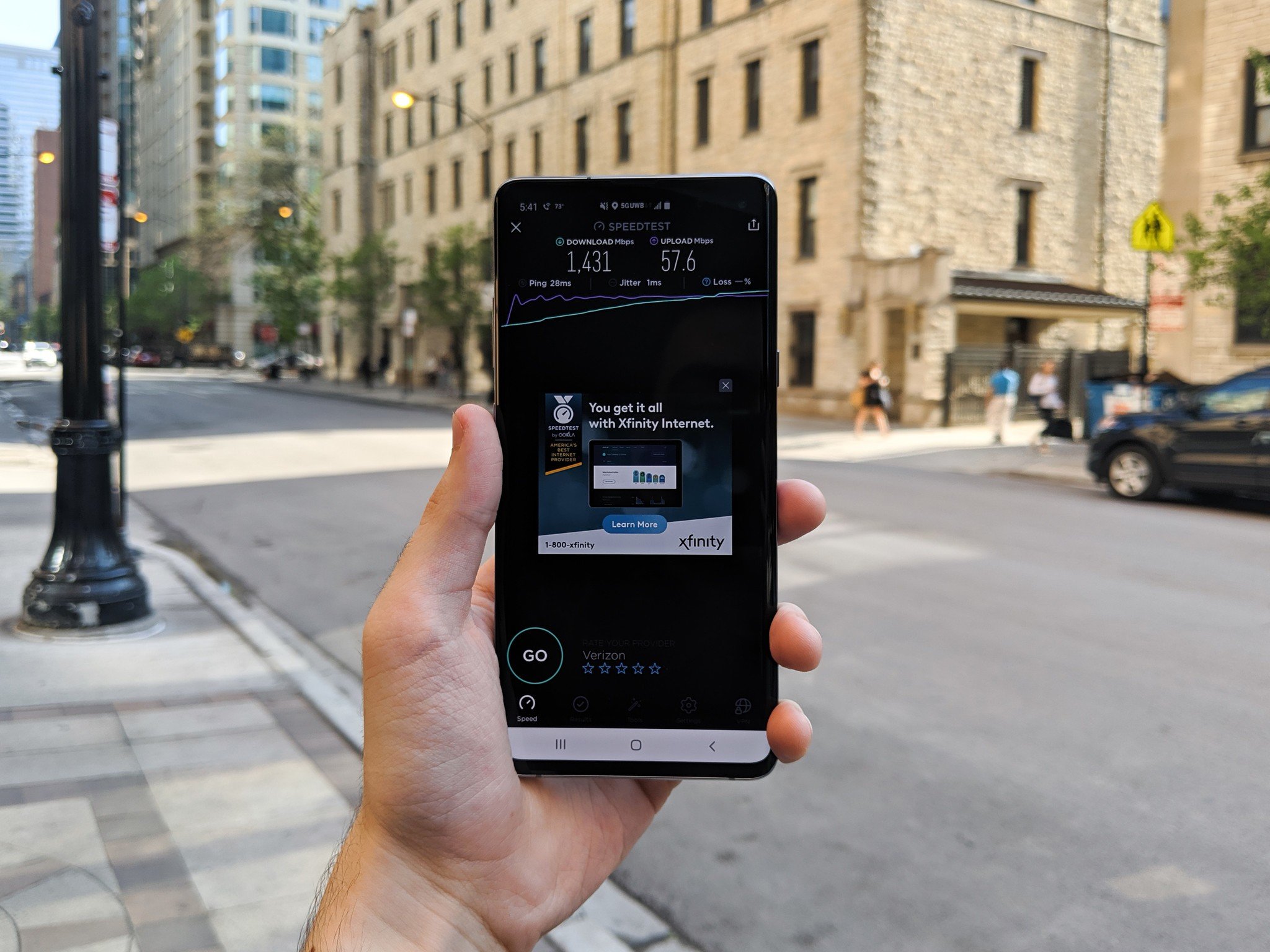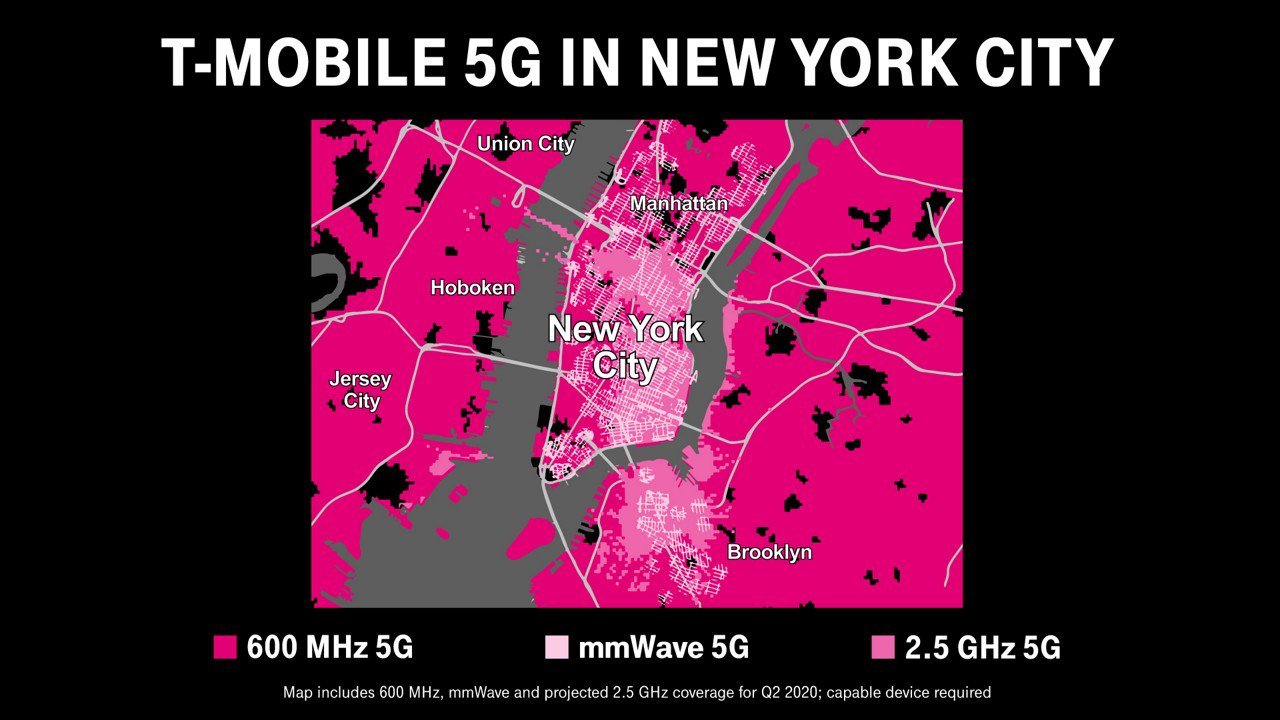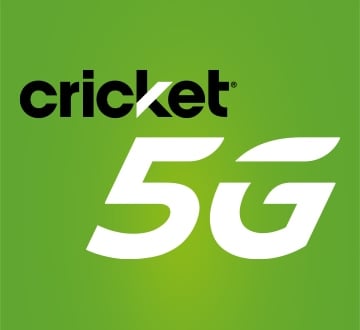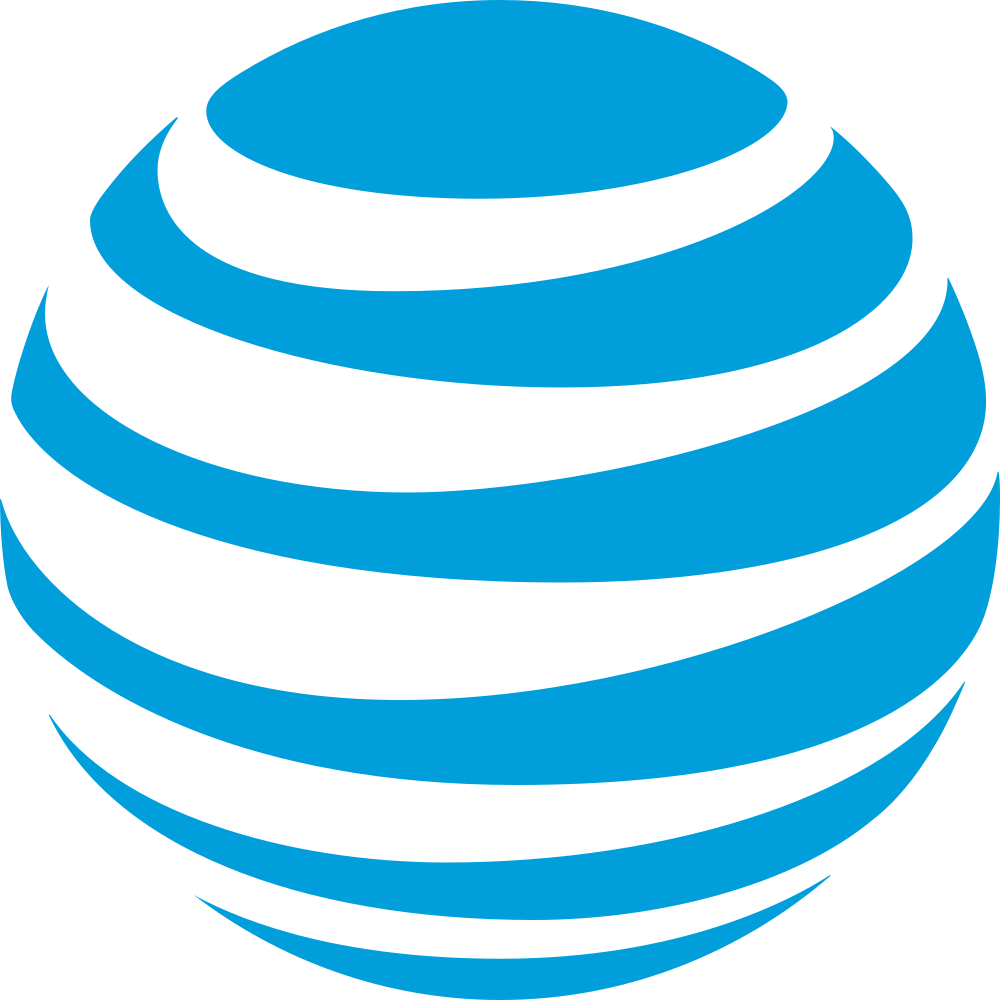5G coverage map: Every US city with AT&T, Verizon, & T-Mobile 5G
Which carrier delivers the best 5G experience?
The 5G experience was a bit underwhelming at first, with mmWave's unreliable coverage and low-band nationwide coverage failing to meet speed expectations. Carriers have continued to plow forward on their 5G networks with the spectrum they already had access to and with new mid-band spectrum gained from FCC auctions and, in the case of T-Mobile, buying Sprint.
AT&T and Verizon got a late start on mid-band coverage, waiting for C-band to become available, as well as dealing with delays and limitations imposed by the FAA. Still, as of February 2022, C-band deployment is underway, and AT&T and Verizon are already starting to close the coverage gap to T-Mobile. It's also nice that most of the best cell phone plans now support 5G, including prepaid options, so no matter which carrier you want to go with, you'll be able to get connected.
For all its advancements, 4G LTE coverage is still greater than 5G for many people. While 5G deployment has been rapid, most of us will still occasionally see LTE on our phones, especially rural customers.
Jump to:Frequencies and coverage| Carrier | Bands |
|---|---|
| Verizon | low-band: n5 and n66 C-band: n77 mmWave: n260 and n261 |
| T-Mobile | low-band: n71 mid-band: n41 mmWave: n258, n260, and n261 |
| AT&T | low-band: n5 C-band: n77 mmWave: n260 (39GHz) |
Building a 5G network is a balance between capacity and coverage. With the highest-frequency bands, known as mmWave, carriers get access to huge chunks of spectrum, allowing for fiber-like speeds over the wireless network. While it's not the first time the frequencies of mmWave bands have been used, this is the first time it has become economically feasible to use them for mobile broadband. Still, progress is slow, and all of the major carriers are focusing a lot more on coverage for the time being.
Lower frequencies are less susceptible to interference, meaning fewer but larger towers need to be built to cover an area than mmWave. Since there is less lower-frequency spectrum available, plus more people will be sharing one tower, speed is much more limited. With mmWave, you will have a tower for smaller areas like a neighborhood. This is kind of like how your Wi-Fi is very fast but only works in your home. As you can imagine, mmWave is very costly and slow to deploy.
T-Mobile got a massive head start on mid-band coverage with band n41 acquired from its purchase of Sprint. This mid-band spectrum allowed T-Mobile to immediately start deploying faster 5G coverage to millions of people with marginally better coverage than C-band. Band n41 is 2.5GHz compared to C-band at 3.7GHz to 4.2GHz. Phone makers have also had more time to get band n41 working, so most of the best Android phones will work out of the box with T-Mobile's 5G network.
AT&T and Verizon have started to build their C-band networks despite a rough start in January 2022. Launching with 90 million people covered, and an expected 100 million people by the end of February, Verizon is off to a strong start. AT&T's C-band debut wasn't quite as flashy, but its network is still underway.
Where Verizon has 5GVerizon's 5G network is expanding quickly. Verizon started small, with only a few cities deploying 5G Ultra-Wideband (UWB). In short, this is mmWave 5G, which uses large chunks of high-frequency bandwidth, around 28GHz, that produce very high speeds but suffer in other areas such as coverage over distance and building penetration. While coverage was dense enough in cities to be included on the list, coverage is still only available outdoors in parts of the cities.
A much more extensive nationwide 5G network is now available using Dynamic Spectrum Sharing (DSS). This network now covers more than 230 million customers and 2,700 cities, according to Verizon. DSS allows Verizon to repurpose its huge amount of existing LTE spectrum to work with both 5G and LTE. The equipment on the towers can allocate the spectrum to the network that needs it most without a significant impact on the LTE network, which most people will still be using for a while.
Furthermore, this nationwide 5G network is available to all customers on any data plan, unlike UWB, which requires an unlimited plan.
Verizon launched C-band in January 2022 to 90 million people with 100 million expected by the end of that month. Verizon's C-band network was hampered by restrictions placed on it by the FAA and backed by President Biden. These restrictions affect areas around airports where it has been determined that C-band could cause interference with certain types of altimeters. This could lead to dangerous false readings in low visibility conditions.
Verizon has a coverage map with both LTE and 5G coverage showing just how much larger its nationwide network already is than the UWB network. Verizon has continued to build its mmWave 5G network and now has coverage in most of the largest cities in the country with many supporting 5G Home internet.
Cities with Verizon Ultra Wideband 5G service- Alabama
- Birmingham (5G Home)
- Arizona
- Phoenix (5G Home)
- Tucson (5G Home)
- Arkansas
- Little Rock (5G Home)
- California
- Anaheim (5G Home)
- Bakersfield (5G Home)
- Fremont (5G Home)
- Fresno (5G Home)
- Los Angeles (5G Home)
- Oakland (5G Home)
- Riverside (5G Home)
- Sacramento (5G Home)
- San Diego (5G Home)
- San Francisco (5G Home)
- San Jose (5G Home)
- Colorado
- Colorado Springs
- Denver (5G Home)
- Connecticut
- Hartford (5G Home)
- Delaware
- Delaware Beaches
- Wilmington
- Florida
- Fort Lauderdale (5G Home)
- Jacksonville (5G Home)
- Miami (5G Home)
- Orlando (5G Home)
- Panama City
- Pensacola (5G Home)
- Sarasota (5G Home)
- St. Petersburg (5G Home)
- Tampa (5G Home)
- Georgia
- Atlanta (5G Home)
- Athens (5G Home)
- Idaho
- Boise
- Illinois
- Chicago (5G Home)
- Indiana
- Fort Wayne (5G Home)
- Indianapolis (5G Home)
- Iowa
- Des Moines (5G Home)
- Kentucky
- Louisville (5G Home)
- Louisiana
- New Orleans (5G Home)
- Maryland
- Baltimore
- Ocean City
- Massachusetts
- Boston
- Michigan
- Ann Arbor (5G Home)
- Detroit (5G Home)
- Grand Rapids
- Minnesota
- Minneapolis (5G Home)
- St. Paul (5G Home)
- Missouri
- Kansas City (5G Home)
- St. Louis (5G Home)
- Nebraska
- Omaha (5G Home)
- Nevada
- Las Vegas (5G Home)
- New Jersey
- Hoboken, NJ
- Jersey City
- Jersey Shore Beaches (5G Home)
- New Mexico
- Albuquerque (5G Home)
- New York
- Albany
- New York
- Niagara Falls (5G Home)
- Syracuse
- North Carolina
- Charlotte (5G Home)
- Durham (5G Home)
- Greensboro (5G Home)
- Raleigh (5G Home)
- Ohio
- Akron (5G Home)
- Cincinnati (5G Home)
- Dayton (5G Home)
- Cleveland (5G Home)
- Columbus (5G Home)
- Oklahoma
- Oklahoma City (5G Home)
- Oregon
- Gresham (5G Home)
- Portland (5G Home)
- Pennsylvania
- Harrisburg
- Philadelphia
- Pittsburgh
- Scranton
- Rhode Island
- Providence
- South Carolina
- Columbia (5G Home)
- Greenville (5G Home)
- South Dakota
- Sioux Falls
- Tennessee
- Knoxville (5G Home)
- Memphis (5G Home)
- Nashville (5G Home)
- Texas
- Arlington (5G Home)
- Austin (5G Home)
- Dallas (5G Home)
- El Paso
- Houston (5G Home)
- San Antonio (5G Home)
- Utah
- Provo (5G Home)
- Salt Lake City (5G Home)
- Virginia
- Norfolk
- Richmond
- Washington
- Seattle (5G Home)
- Spokane (5G Home)
- Tacoma (5G Home)
- Washington D.C.
- Wisconsin
- Milwaukee (5G Home)
Catching up quickly
Verizon's 5G network is expanding quickly, and with nationwide 5G now available, there's a solid chance you have access to Verizon's 5G network as long as you have a 5G phone.
Where T-Mobile has 5GT-Mobile has the largest 5G network by a considerable margin. T-Mobile started building a 28GHz or 29GHz high-band mmWave network in the middle of 2019 before following it up with 5G on its 600MHz spectrum. While this lower-frequency 5G isn't as fast as we've seen with mmWave networks, its extensive coverage area makes it more practical for users. T-Mobile has now been able to fully implement and expand Sprint's 5G spectrum into its network, helping it become the largest 5G network and the fastest, according to OpenSignal.
Nationwide coverageT-Mobile already has an interactive 5G coverage map ready to go. Most 5G phones on T-Mobile support the entire network now, including some of the biggest names like Samsung's Galaxy S21 series and the Pixel 6 phones. Some older phones will work with both networks, such as the OnePlus 7T Pro 5G McClaren. Most 5G phones you can still find for sale will support the entire network. Look for bands n41 and n71, to be sure.
T-Mobile's largest coverage area is provided by its Extended Range 5G, which as of January 2022, covers more than 310 million people. The coverage map for this network looks a lot like T-Mobile's LTE network, and speeds are only getting better as the Ultra-Capacity network continues to grow.
Metro by T-Mobile, Mint Mobile, Google Fi, and several other T-Mobile-based prepaid carriers offer 5G on supported phones. However, unlike AT&T and Verizon prepaid carriers, there's no special plan or additional fees to use it.
Layer cake and 5G SAT-Mobile's sub-6 network is on bands n71 and n41 (Sprint) at 600MHz and 2.5GHz, respectively. Its mmWave network is on n260 and n261 at 39GHz and 28GHz. Simply put, a higher frequency has less range and has worse building penetration but much greater potential for high speeds. T-Mobile's band n41 5G and mmWave 5G are collectively referred to as Ultra Capacity 5G and are now visible on T-Mobile's coverage map.
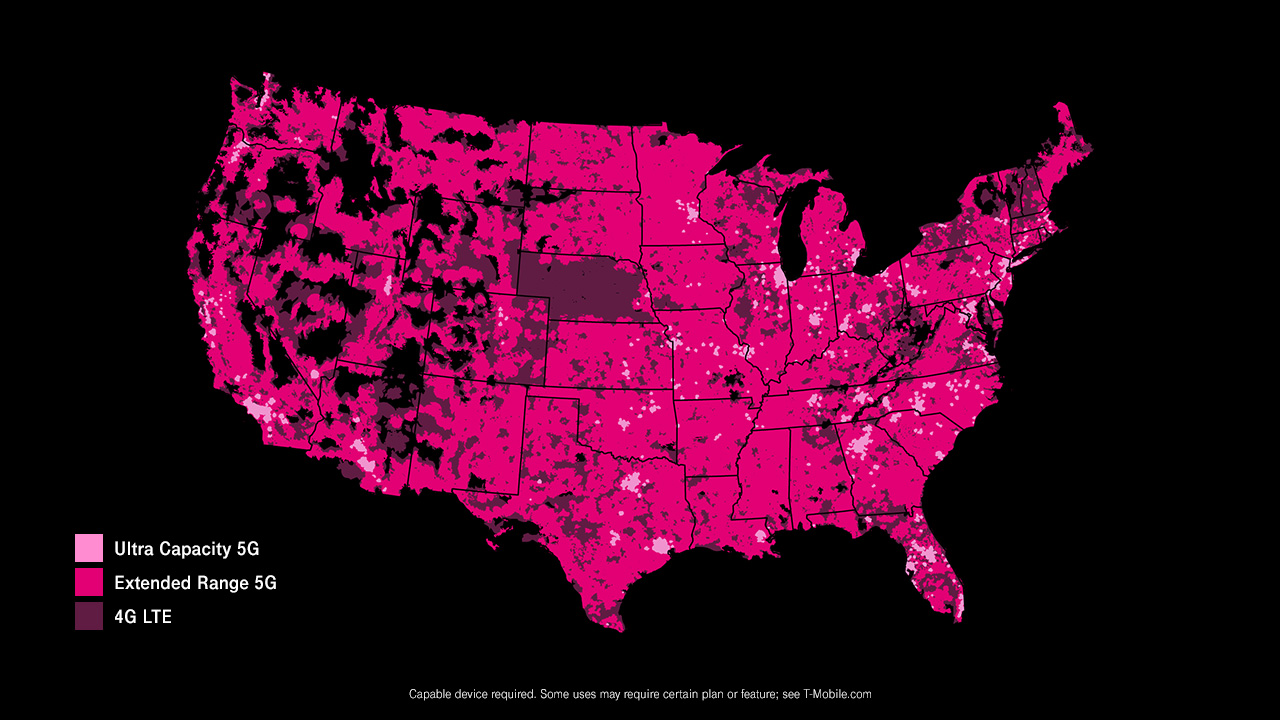 Ultra Capacity 5G refers to 2.5GHz band n41. Extended Range 5G refers to 600MHz band n71.
Ultra Capacity 5G refers to 2.5GHz band n41. Extended Range 5G refers to 600MHz band n71.
In our earlier testing, the raw speed with T-Mobile's n71 600MHz sub-6 network increases compared to LTE weren't anything to write home about. The problem is twofold since there is relatively less bandwidth available on this long-range spectrum, and a phone may prefer to connect to a weaker 5G signal over a stronger LTE signal. This puts 5G in a worst-case scenario for head-to-head speeds.
To improve this, T-Mobile will continue to upgrade more towers with 5G capabilities. One of the most significant developments has been the move to standalone 5G or 5G SA. Previous deployments of 5G required a connection to LTE to work correctly. This setup could severely limit network responsiveness and coverage. With 5G SA, T-Mobile is reporting around a 30 percent increase in its 5G coverage and a 40 percent improvement in latency. T-Mobile has also improved speeds with carrier aggregation.
Another upgrade is the added support for n41 2.5GHz 5G. Sprint managed to secure quite a bit of spectrum, so speeds are a decent upgrade over LTE for the most part, but it doesn't reach nearly as far. Of course, T-Mobile customers with compatible phones and Sprint customers with a Galaxy S20 series phone will be able to access both bands on T-Mobile's 5G network.
T-Mobile's Ultra Capacity 5G covers 210 million people. The Ultra Capacity network has speeds ranging from 300Mbps to 1Gbps and will handle much more traffic than Extender Range 5G or LTE. This mid-band spectrum has given T-Mobile a massive head start over the others that needed to wait for C-band.
Finally, if you're looking for pure speed, mmWave is the answer but has a range more similar to Wi-Fi than sub-6 5G. With a tower struggling to cover a city block and useless on the far side of a brick wall, it's better suited to very dense areas and even buildings like stadiums. With the cost of tower installation multiplied by the vast number of towers needed, mmWave will take years to build out.
High-band, mmWave coverage is available in parts of these cities.
- California
- Los Angeles
- Georgia
- Atlanta
- Nevada
- Las Vegas
- New York
- New York
- Ohio
- Cleveland
- Texas
- Dallas
Sprint has now been rebranded as T-Mobile, but Sprint customers will continue to use the Sprint network for now. Sprint customers will be brought to the T-Mobile network in time, but it has yet to announce a date when that could happen.
New 5G phones purchased for Sprint plans can now use T-Mobile's 5G network as long as they support it. However, that means that Sprint customers with an older Sprint-specific 5G phone like the Galaxy S10 5G will get kicked back to LTE since the Sprint version doesn't work with T-Mobile's network. Sprint's coverage maps don't even show 5G anymore.
T-Mobile 5GLayer CakeThe biggest 5G network
T-Mobile is building a nationwide 5G network on low-band and mid-band spectrum. It isn't charging customers anymore to get on it. With T-Mobile, all you need is the phone and coverage to get 5G.
Where AT&T has 5GAT&T certainly has a very impressive list of cities with available 5G coverage. AT&T has launched the majority of its 5G network for business use. AT&T started with millimeter-wave and has also launched its nationwide 5G network based on its 850MHz spectrum and DSS in some areas. AT&T's network is one of the fastest overall thanks to its excellent LTE network speeds, and it's quickly catching up to T-Mobile with its sub-6 5G.
AT&T has 5G coverage for 250 million people with additional mmWave capacity in parts of 42 cities across the country. This has surpassed the goal of 40 in 2021, and AT&T expects to add even more before the end of the year. AT&T has also launched a C-band network with coverage in eight cities with more to follow.
AT&T uses DSS (Dynamic Spectrum Sharing) to share portions of the spectrum currently only used for LTE with its 5G network in some areas. This will allow towers to use spectrum as needed and provide a smooth transition to 5G without taking portions of LTE fully offline. Interestingly, AT&T now offers 5G roaming in Japan thanks to an agreement with NTT DOCOMO.
If you want to access 5G, you'll need one of AT&T's unlimited plans. While there will likely be some improvement over LTE using this 850MHz 5G, it's not going to hit the super-fast speeds we've seen with mmWave. Still, the 850MHz deployment should have better coverage than mmWave and be faster than 4G LTE.
5G is now shown on AT&T's standard coverage maps which makes it easier than ever to see how far this coverage has made it. However, these maps do take a while to get updated, so check out the entire list for the most up-to-date locations.
Prepaid AT&T MVNO Cricket Wireless also now supports 5G on all of its plans. So if you're looking for a cheap way to try out AT&T's 5G, Cricket is a great option.
5G+ mmWave CoverageCities
- Arizona
- Phoenix
- California
- Los Angeles
- Menlo Park
- Oakland
- Redwood City
- San Bruno
- San Diego
- San Francisco
- San Jose
- West Hollywood
- Florida
- Jacksonville
- Miami
- Miami Gardens
- Orlando
- Tallahassee
- Tampa
- Georgia
- Atlanta
- Indiana
- Indianapolis
- Illinois
- Chicago
- Kentucky
- Louisville
- Louisiana
- New Orleans
- Maryland
- Baltimore
- Ocean City
- Michigan
- Detroit
- North Carolina
- Charlotte
- Raleigh
- Nevada
- Las Vegas
- New York
- New York City
- Ohio
- Cleveland
- Oklahoma
- Oklahoma City
- Pennsylvania
- King of Prussia
- Philadelphia
- Tennessee
- Nashville
- Texas
- Austin
- Corpus Christi
- Dallas
- Fredericksburg
- Houston
- San Antonio
- Waco
- Wisconsin
- Milwaukee
Airports
- California
- Los Angeles International Airport
- Florida
- Tampa International Airport
- Illinois
- Chicago Midway International Airport
- O'Hare International Airport
- Texas
- Dallas Love Field Airport
Arenas and Venues
- Arizona
- State Farm Stadium
- California
- Dodger Stadium - Los Angeles
- Oracle Park - San Francisco
- Colorado
- Ball Arena - Denver
- Florida
- Amway Center - Orlando
- Hard Rock Stadium - Miami
- Raymond James Stadium -Tampa
- Georgia
- Mercedes-Benz Stadium - Atlanta
- Illinois
- United Center - Chicago
- Indiana
- Lucas Oil Stadium - Indianapolis
- Louisiana
- Caesars Superdome - New Orleans
- Smoothie King Center - New Orleans
- Massachusetts
- TD Garden - Boston
- Minnesota
- U.S. Bank Stadium - Minneapolis
- Target Center - Minneapolis
- Nevada
- Las Vegas Convention Center - Las Vegas
- New Jersey
- Red Bull Arena - Harrison
- North Carolina
- Bank of America Stadium - Charlotte
- Spectrum Center - Charlotte
- Ohio
- Rocket Mortgage Fieldhouse - Cleveland
- Oklahoma
- Paycom Center - Oklahoma City
- Pennsylvania
- Wells Fargo Center - Philadelphia
- Texas
- AT&T Dallas Stadium - Arlington
- AT&T Center - San Antonio
- Kay Bailey Hutchison Convention Center - Dallas
- Toyota Center - Houston
- Utah
- Vivint Arena - Salt Lake City
- Washington
- Lumen Field
- Washington D.C.
- AT&T Forum
- Capital One Arena
- Wisconsin
- American Family Field - Milwaukee
- Fiserv Forum - Milwaukee
5G+ will also be accessible to first responders as part of AT&T's FirstNet program. This program is designed to keep first responders connected with AT&T's 5G network and the LTE network, as the system is designed to always find the fastest possible connection. This allows FirstNet to maintain interoperability, ensuring first responders stay connected regardless of the device or network.
5GE is not 5GIf you have an AT&T phone, you have seen your phone indicate a 5GE connection even if you don't have a 5G phone or plan that supports 5G. This is because 5GE is not 5G. To deploy 5G, a carrier needs a fast fiber connection to the network and upgraded equipment. A 5GE connection is technically LTE but with the most modern hardware and close to a best-case scenario. You may get speeds faster than typical LTE with 5GE, but the fact of the matter is, it's just good 4G LTE.
AT&T has stopped advertising this name recently, but some people with LTE phones may still see it pop up in some areas. For what it's worth, 5GE represents the best of what LTE can do and should deliver great performance.
AT&T 5GCoverage 5GLow-band and mmWave working together
AT&T's 5G network has been playing coverage catchup with its sub-6 rivals but is closing the gap fast and already covers 250 million people in the U.S.
Other carriersJust about every wireless provider has its eye on 5G, and that's no different for UScellular. UScellular provides great wireless service in a much smaller area than the big three, with most of its efforts focused on Iowa and Wisconsin. Still, this hasn't stopped UScellular from building a very respectable low-band 5G network on its 600MHz spectrum in many of the areas it serves across the nation. If you love your U.S. Mobile service, you don't need to switch to get 5G. Check UScellular coverage map to see its current coverage.
DISH Network is another carrier to keep an eye on if you're interested in 5G networks. While DISH hasn't yet started service on its network just yet, it is hard at work building a network and even bought Boost Mobile as well as Sprint's 800MHz spectrum as part of T-Mobile's purchase of Sprint.
Update, February 7, 2022: Revised intro paragraph to fit better with modern 5G deployments. Added C-band coverage information. New coverage figures for AT&T, T-Mobile, and Verizon have been added.
